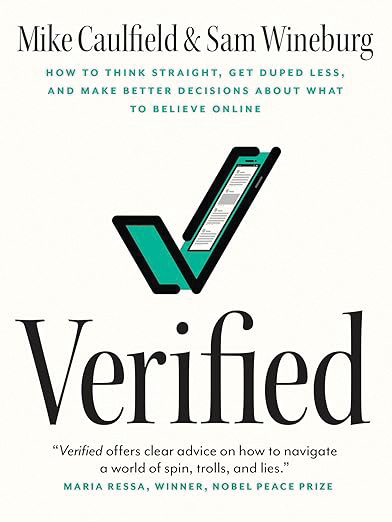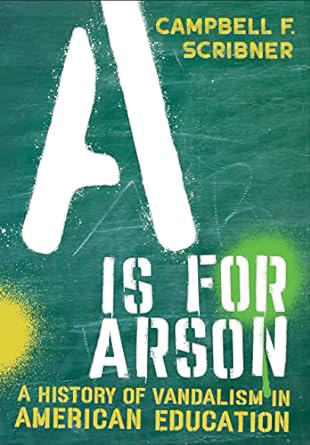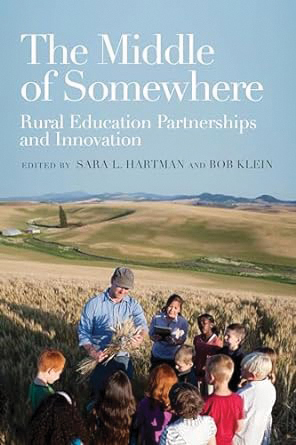Syllabus: May 2024
Verified: How to Think Straight, Get Duped Less, and Make Better Decisions about What to Believe Online

In an age when students get most of their news off TikTok, it’s imperative for educators to guide them in how to conduct web-based research and verify fact from fiction. Enter Mike Caulfield and Sam Wineburg with their easy and fast read, Verified: How to Think Straight, Get Duped Less, and Make Better Decisions about What to Believe Online (University of Chicago Press). Using concrete tools and examples, Caulfield, a research scientist at the University of Washington’s Center for an Informed Public, and Wineburg, professor emeritus at Stanford University, give us “the internet driver’s manual you never got” through their method, SIFT, or Stop, Investigate the source, Find other coverage, and Trace the claim, quote, or media to the original context. The authors also explain how to read and access more scholarly work, how to use Wikipedia wisely, and how to identify propaganda, doctored video and imagery, and sponsored content. These methods, while not foolproof, are also not tedious, and can help educators guide students in reading, writing, and thinking critically in this fast-paced time.
—Brendy Siev | Assistant Principal
Kosloff Torah Academy, Bala Cynwyd, PA
Balance Screen Time With Green Time: Connecting Students With Nature

Humans do better when they interact with each other and spend time in nature rather than spending time with screens. That’s the thrust of Emily Morgan’s book, Balance Screen Time With Green Time: Connecting Students With Nature (Corwin). Morgan, an author and former science teacher, explains how “green time” and being with adults who care for nature can positively impact a child’s attitude toward natural surroundings and encourage them to become more environmentally aware as they grow older. Other positive benefits include fostering hope instead of worry and helping students develop social skills, physical, and mental health, and improved behavior. The book features 25 green-based activities with academic connections, which educators are sure to find useful. Such activities involve wonder walks, rooftop gardens, and outdoor learning centers, among other green spaces where students can engage with others and develop healthy habits by intentionally doing more with nature.
—Susan C. Paul, EdD | Principal
Kaiserslautern High School, Germany, Department of Defense Education Activity
A is for Arson: A History of Vandalism in American Education

As any school administrator knows, vandalism is a challenge to address and proactively manage. In A is for Arson: A History of Vandalism in American Education (Cornell University Press), Campbell F. Scribner examines school property destruction through a historical lens that extends back to the late 18th and 19th centuries. Scribner, an assistant professor of education policy at the University of Maryland, College Park, divides his book into three parts, which examine vandalism as political resistance, a process of self-discovery, and random and chaotic expression. While vandalism may be seen as a modern moral issue, Scribner shows that it’s been around for years. Causes range from student boredom to dilapidated and uncomfortable classrooms and schoolhouses to community conflict over school governance or disapproval with teachers. As Scribner rightfully notes, the topic is unwieldy, and vandals don’t speak with a single voice. A is for Arson ultimately encourages educators to think critically about how to be a steward of scarce resources, while also trying to engage and educate students who have not yet found their way.
—Eric Fox | Assistant Principal
Jenks High School, Jenks, OK
The Middle of Somewhere: Rural Education Partnerships and Innovation

In my teaching career, I’ve had the privilege of working in both rural and urban school districts. Some challenges in education are universal, but some exist simply based on geography. Take for example, work-based learning internships that offer students both credit and career exploration. In large urban school districts, finding an array of internship opportunities is straightforward given the diverse businesses represented. However, small towns often lack these opportunities and the nearest city that may offer them might be four to five hours away. To combat the challenges of geographic isolation, rural schools have formed trilateral partnerships that connect the resources of the school district, the local community, and institutions of higher education. Such partnerships from Ohio to Mississippi to Texas and Montana are highlighted in The Middle of Somewhere: Rural Education Partnerships and Innovation (Harvard Education Press), edited by Sara L. Hartman and Bob Klein, professors at Ohio University. Their book offers case studies of innovations that all bear fruit from leveraging the strengths, not weaknesses, of rural communities. Regardless of where you teach, The Middle of Somewhere provides valuable insights into how education can benefit from strong partnerships to make school more flexible and personalized, while better preparing students for college and a future career.
—Alan Stanfield | Assistant Principal
Glacier High School, Kalispell, MT
